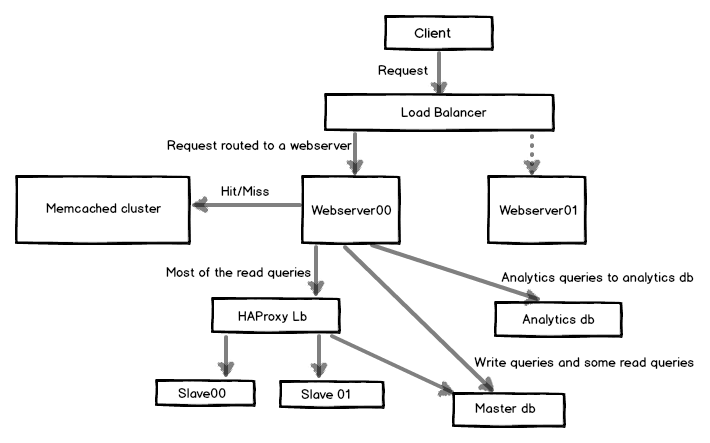Scaling database with Django and HAProxy
###MySQL - Primary data store At HackerEarth, we use MySQL database as the primary data store. We have experimented with a few NoSQL databases on the way, but the results have been largely unsatisfactory. The distributed databases like MongoDB or CouchDB aren’t very scalable or stable. Right now, our status monitoring services use RethinkDB for storing the data in JSON format and that’s all for the NoSQL database usage right now.
With the growing data and number of requests/sec, it turns out that the database becomes the major bottlneck to scale the application dynamically. At this point if you are thinking that there are mythical (cloud) providers who can handle the growing need of your application, you can’t be more wrong. To make the problem even harder, you can’t spin a new database whenever you want to just like your frontend servers. To achieve a horizontal scalability at all levels, it requires massive rearchitecture of the system while being completely transparent to the end user. This is what a part of our team has focussed on in last few months, resulting in very high uptime and availability.
The master (and only) MySQL database had started being under heavy load recently. We thought we will delay any scalability at this level till the single database could handle the load, and we will work on other high priority things. But that was not supposed to go as planned and we experienced a few downtimes. After that we did a rearchitecture of our application, sharded the database, wrote database routers and wrappers on top of django ORM, put HAProxy load balancer infront of the MySQL databases, and refactored our codebase to optimize it significantly.
The image below shows a part of the architecture we have at HackerEarth. Many other components have been omitted for simplicity.

###Database slaves and router The idea was to create read replicas and route the write queries to master database and read queries to slave (read replica) databases. But that was not so simple again. We couldn’t and wouldn’t want to route all the read queries to slaves. There were some read queries which couldn’t afford stale data, which comes as a part of database replication. Though stale data might be the order of just a few seconds, these small number of read queries couldn’t even afford that.
The first database router was simple:
class MasterSlaveRouter(object):
"""
Represents the router for database lookup.
"""
def __init__(self):
if settings.LOCAL:
self._SLAVES = []
else:
self._SLAVES = SLAVES
def db_for_read(self, model, **hints):
"""
Reads go to default for now.
"""
return 'default'
def db_for_write(self, model, **hints):
"""
Writes always go to default.
"""
return 'default'
def allow_relation(self, obj1, obj2, **hints):
"""
Relations between objects are allowed if both objects are
in the default/slave pool.
"""
db_list = ('default',)
for slave in zip(self._SLAVES):
db_list += slave
if obj1._state.db in db_list and obj2._state.db in db_list:
return True
return None
def allow_migrate(self, db, model):
return True
All the write and read queries go the master database, which you might think is
weird here. Instead, we wrote get_from_slave(), filter_from_slave(),
get_object_or_404_from_slave(), get_list_or_404_from_slave(), etc. as part of
django ORM in our custom managers to read from slave. So whenever we know we
can read from slaves, we call one of these functions. This was a sacrifice made
for those small number of read queries which couldn’t afford the stale data.
Custom database manager to fetch data from slave:
# proxy_slave_X is the HAProxy endpoint, which does load balancing
# over all the databases.
SLAVES = ['proxy_slave_1', 'proxy_slave_2']
def get_slave():
"""
Returns a slave randomly from the list.
"""
if settings.LOCAL:
db_list = []
else:
db_list = SLAVES
return random.choice(db_list)
class BaseManager(models.Manager):
# Wrappers to read from slave databases.
def get_from_slave(self, *args, **kwargs):
self._db = get_slave()
return super(BaseManager, self).get_query_set().get(*args, **kwargs)
def filter_from_slave(self, *args, **kwargs):
self._db = get_slave()
return super(BaseManager, self).get_query_set().filter(
*args, **kwargs).exclude(Q(hidden=True) | Q(trashed=True))
###HAProxy for load balancing
Now the slaves could be in any number at a time. One option was to update the
database configuration in settings whenever we added/removed a slave. But that
was very cumbersome and inefficient. The other better way was to put a
HAProxy
load balancer in front of all the databases and let it detect which one is up
or down and route the read queries according to that. This would mean never
editing the database configuration in our codebase, just what we wanted.
A snippet of /etc/haproxy/haproxy.cfg:
listen mysql *:3305
mode tcp
balance roundrobin
option mysql-check user haproxyuser
option log-health-checks
server db00 db00.xxxxx.yyyyyyyyyy:3306 check port 3306 inter 1000
server db01 db00.xxxxx.yyyyyyyyyy:3306 check port 3306 inter 1000
server db02 db00.xxxxx.yyyyyyyyyy:3306 check port 3306 inter 1000
The configuration for slave in settings now looked like this:
DATABASES = {
'default': {
'ENGINE': 'django.db.backends.mysql',
'NAME': 'db_name',
'USER': 'username',
'PASSWORD': 'password',
'HOST': 'db00.xxxxx.yyyyyyyyyy',
'PORT': '3306',
},
'proxy_slave_1': {
'ENGINE': 'django.db.backends.mysql',
'NAME': 'db_name',
'USER': 'username',
'PASSWORD': 'password',
'HOST': '127.0.0.1',
'PORT': '3305',
},
'analytics': {
'ENGINE': 'django.db.backends.mysql',
'NAME': 'db_name',
'USER': 'username',
'PASSWORD': 'password',
'HOST': 'db-analytics.xxxxx.yyyyyyyyyy',
'PORT': '3306',
},
}
But there is a caveat here too. If you spin off a new server with the haproxy configuration containing some endpoints which doesn’t exists, haproxy will throw an error and it won’t start, making the slave useless. It turns out there is no easy solution to this, and haproxy.cfg should contain existing server endpoints while initializing. The solution then was to let the webserver update its haproxy configuration from a central location whenever it starts. We wrote a simple script in fabric to do this. Besides, the webserver already used to update its binary when spinned off from an old image.
###Database sharding Next, we sharded the database. We created another database - analytics. It stores all the computed data and they form a major part of read queries. All the queries to analytics database are routed using the following router:
class AnalyticsRouter(object):
"""
Represents the router for analytics database lookup.
"""
def __init__(self):
if settings.LOCAL:
self._SLAVES = []
self._db = 'default'
else:
self._SLAVES = []
self._db = 'analytics'
def db_for_read(self, model, **hints):
"""
All reads go to analytics for now.
"""
if model._meta.app_label == 'analytics':
return self._db
else:
return None
def db_for_write(self, model, **hints):
"""
Writes always go to analytics.
"""
if model._meta.app_label == 'analytics':
return self._db
else:
return None
def allow_relation(self, obj1, obj2, **hints):
"""
Relations between objects are allowed if both objects are
in the default/slave pool.
"""
if obj1._meta.app_label == 'analytics' or \
obj2._meta.app_label == 'analytics':
return True
else:
return None
def allow_migrate(self, db, model):
if db == self._db:
return model._meta.app_label == 'analytics'
elif model._meta.app_label == 'analytics':
return False
else:
return None
To enable the two routers, we need to add them in our global settings:
DATABASE_ROUTERS = ['core.routers.AnalyticsRouter', 'core.routers.MasterSlaveRouter']
Here the order of routers is important. All the queries for analytics are routed to the analytics database and all the other queries are routed to the master database or their slaves according the nature of queries. For now, we have not put slaves for analytics database but as the usage grows that will be fairly straightforward to do now.
At the end, we had an architecture where we could spin off new read replicas, route the queries fairly simply and had a high performance load-balancer in front of the databases. All this has resulted in much higher uptime and stability in our application and we could focus more on what we love to do - building products for programmers. We already had an automated deployment system in place, which made the exprimentation easier and enabled us to test everything thoroughly. The refactoring and optimization that we did in codebase and architecture also helped us to reduce the servers count by more than two times. This has been a huge win for us, and we are now focussing on rolling out exciting products in next few weeks. Stay tuned!
I would love to know from others about how they have solved similar problems, give suggestions and point out potential quirks.
P.S. You might be interested in The HackerEarth Data Challenge that we are running.
Posted by Vivek Prakash. Follow me @vivekprakash. Write to me at vivek@hackerearth.com.

